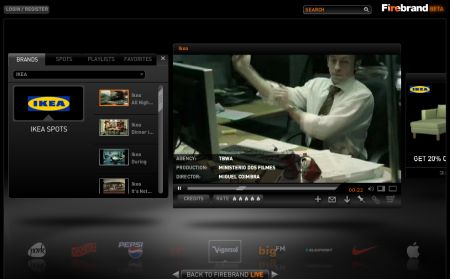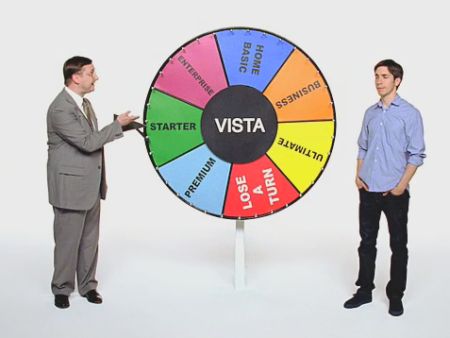von Roland Hachmann | Nov. 29, 2007 | Ad News, Blog, Digital Marketing, Marketing, Online Advertising
Firebrand now launched, and it has a wide selection of TV commercials online to watch. You can filter them by brand, animation, celebrity, etc. I particularly like the filter-selection „banned“, which could be quite promising in the future.
What I miss: you can’t comment on the ads. You can rate them, but not comment on them. Might be due to lack of editorial staff, and I hope that is the only reason. Because some say, it might be, because advertisers have expressed concerns about people commenting on ads.

One intelligent feature: as you can see on the screenshot above: offers of the advertisers can be integrated as clickable banners. Not sure if that always corresponds to what has been shown in the ad, but it would make sense.
So who will actually use this? Some people who seek entertainment? They would go to YouTube, wouldn’t they? And the ad folks? Only if this becomes more complete than other ad databases (including YouTube).
And what about including good print advertising?
von Roland Hachmann | Nov. 26, 2007 | Blog, Digital Marketing, Online Advertising
Doing some research regarding viral marketing, I stumbled upon the following 5 posts, here is a summary of each:
- 4 myths of viral marketing: it is a replacement for television (most videos won’t get millions of viewers), a viral video is a digital strategy (what happens after the video has been watched?), putting a video on YouTube is a digital strategy (most videos don’t really go viral without some help or trigger), bloggers are just waiting for videos they can write about (because there is so little other information around in this world).
- 7 deadly sins of advertising via viral video: Make a white and brown cow (instead of a purple, remarkable cow), pretend you’re not advertising (hoping it doesn’t backfire or gets ignored), spend a fortune on production (instead of a good idea), tell consumer instead of engage them (it’s not an adaptation of a 30 sec. spot), do a video contest because everyone else does (soon enough, it will get ever more difficult to activate consumers to the umpteenth contest), set unrealistic conversion measures (it’s not about conversion anyway, in most cases), throw in the towel and decide to just advertise around viral videos (at least to both in partnership).
- Why everyone wants viral video: 57 million Americans watch online video content every day. That’s 19% of the online population. 13% of American adults report they have downloaded or watched video ads! Two out of three viewers ages 18-29 send links to video files, compared with half of Americans age 30 and older. Forty-two percent of the 18-29 year-olds send video links a few times per month or more
- Is mass marketing important for viral success: Duncan Watts has modeled the viral phenomenon stating that it is not as contagious as we would like it to be. The circle of influence of superspreaders is far smaller than we thought, which this paper is about, and campaigns are subject to complete randomness, which makes this a channel in need of support of planned (i.e. media supported) advertising. Not true writes Nigel Hollis, saying that the stickiniess factor of the creative is not subject to randomness, as it can be pre-tested in focus groups.
- Is word of mouth a discipline or a channel: Discipline: Word of mouth marketing takes belief (based on understanding and knowledge) and discipline. Channel: The media buying companies and some advertising agencies want to see WOM as a channel. Discipline: To deliver on the promise of social media, word of mouth marketing, influencer marketing, conversation marketing – whatever part of WOM you want to emphasize – we need a simple, shared approach to measurement that compares well to what brand managers are used to. Channel: Many ad-based marketers see viral video as the answer to their WOM aspirations. And the conclusion: Word of mouth is a broad discipline like advertising or public relations. It requires technique and methodologies that are particularly relevant to do it well. It is possible to treat it like a channel by tacking on some WOM tactic to a larger advertising program, but it may not pay off in comparison to those more traditional marketing tactics.
von Roland Hachmann | Nov. 20, 2007 | Ad News, Blog, Digital Marketing, Marketing, Marketing Trends, Online Advertising, Social Media Marketing
Sofar, advertising on joost has only been in the form of short ads at the beginning or end of clips. Sort of like the traditional ad model.
Now we have the first attempt at actually providing added value through a marketing tactic. In this case, a widet:
On Thursday, Joost announced that Coca-Cola’s European division has created the first „commercial widget“ for the software. Called „Coke Bubbles,“ the downloadable advertising widget lets you choose a clip on Joost and then send it to fellow Joost users, appended with a note in the form of a „bubble.“
You can download it at „Coke Bubbles„. While I am unsure about whether this is a really clever idea, I do support the fact that Coke does not just run ads in the clips, but does try to provide added value. It’s a first step in the right direction.
A lot of marketing efforts will have to provide a clear added value in the future. Either through real product information at the points where consumers are seeking information. Or, alternatively, if consumers are not seeking product information, brands can help to provide plattforms, contents or tools for entertainment or networking – two of the other main things people seek out in digital media these days.
von Roland Hachmann | Nov. 16, 2007 | Blog, Digital Culture, Digital Marketing, Marketing, Marketing Trends, Online Advertising, Social Media Marketing
(Only two Links today:)
von Roland Hachmann | Nov. 15, 2007 | Blog, Online Advertising
Apple continues its PC vs Mac series. There is quite a range of spots online already.

von Roland Hachmann | Nov. 12, 2007 | Ad News, Blog, Digital Culture, Digital Marketing, Marketing Trends, Online Advertising, Social Media Marketing
https://www.youtube.com/watch?v=WeYMoz0zdag



 Wo ich sonst so bin...
Wo ich sonst so bin...